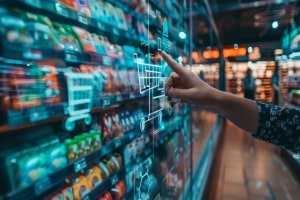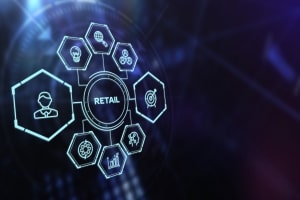 In retail, the Internet of Things (IoT) is facilitating a rapid digital transformation. IoT devices can track inventory, personalize customer experiences, and redefine how retailers engage their shoppers and manage their retail environments. This functionality brings opportunity, but many decision makers and leaders in retail struggle to manage the complexities of these new device ecosystems.
In retail, the Internet of Things (IoT) is facilitating a rapid digital transformation. IoT devices can track inventory, personalize customer experiences, and redefine how retailers engage their shoppers and manage their retail environments. This functionality brings opportunity, but many decision makers and leaders in retail struggle to manage the complexities of these new device ecosystems.
This article goes into more detail about the benefits, use cases, and limitations of IoT solutions development in retail spaces. Despite its many useful applications, IoT can present new challenges to workflow consistency, compliance, and more. Diligence is essential in using emerging technology trends to evolve retail spaces for the better.
Current State of IoT in Retail
To use them successfully in their organizations, technology leaders and retail managers must be aware of and understand the most prevalent trends in IoT device integration.
Market Overview
According to industry analysts, global retail spend on IoT device networks surpassed $52.4 billion in 2023 and is projected to grow at a 29.3% CAGR until 2030. This growth is spurred by several implementation trends that define how IoT solutions are adopted in retail:
- Omnichannel Retail: Retailers now aim for omnichannel customer experiences where online and offline storefronts are connected through devices and sensors that personalize shopping experiences for greater consistency.
- AI Integration: IoT devices generate large amounts of customer behavior data that modern algorithms can model and use as more accurate demand forecasts.
- Sustainability: Modern organizations can use IoT devices to track their energy usage and waste, making real-time adjustments to their systems to support compliance regulations and sustainability goals.
IoT ecosystems are part of an evolving market. Retailers adopting IoT must recognize that continuous monitoring and improvement are essential to remaining competitive and compliant.
Important IoT Applications in Retail
Retail applications for IoT devices include numerous ways to personalize the shopping experience, add conveniences, and strengthen marketing ROI. There are three essential categories of investment that retail organizations should focus on:
1. Inventory Management
 Real-time inventory visibility has many benefits, including automatic stock tracking, fewer errors, real-time reordering systems, and more efficient fulfillment. Smart shelves, connected POS scanners, and RFID item tags can combine to create an interconnected network of real-time inventory management. This can prevent shrinkage by preventing miscounts, automatically reordering low stock items, and spotting inventory theft more efficiently.
Real-time inventory visibility has many benefits, including automatic stock tracking, fewer errors, real-time reordering systems, and more efficient fulfillment. Smart shelves, connected POS scanners, and RFID item tags can combine to create an interconnected network of real-time inventory management. This can prevent shrinkage by preventing miscounts, automatically reordering low stock items, and spotting inventory theft more efficiently.
2. Customer Experience
Retail IoT devices can personalize customer experiences in stores while delivering dynamic, real-time data updates to marketers and managers. Examples of smart IoT devices include beacons that target shoppers for special offers delivered by text, interactive kiosks or displays to aid in product discovery, and queue management servers that help customers avoid service wait times and reduce strain on workers on the floor.
Many of the most respected retail chains already deploy customer experience IoT and plan to increase their investment. IKEA, for example, has recently rolled out a smart customer service queue system connected to kiosks. Customers can sign in and then track their place in line on their phones as they shop. This not only improves the customer’s experience by reducing or eliminating their wait time for in-store service but also drives foot traffic throughout the store.
3. Payment and Security
Modern retail experiences often rely on contactless payment systems and self-checkout resources. IoT devices enable retailers to create frictionless checkout experiences through smartphones and wearables, reducing transaction times and improving customers’ overall experience.
On the security side, retailers deploying IoT networks can also gain the benefits of smarter threat detection and disaster prevention without increasing headcount. For example, smart cameras can detect threats without worker intervention, while IoT-assisted access control systems can keep facilities more secure without increasing the number of human security workers.
4. Environmental Control
Equipped with temperature sensors, smart fire detection systems, and more, many businesses can upgrade their environmental monitoring workflows to protect their assets without investing in infrastructure overhauls.
For example, retailers dealing with food, medicine, and other perishables can use smart environmental sensors to keep a real-time watch over the storage conditions of their products. Sensors can detect when conditions pass preset safety guidelines and initiate automatic alerts.
Overcoming Implementation Challenges
 Despite the benefits and use cases of IoT device networks in retail, they come with implementation challenges. The three main ones are integration, security, and cost.
Despite the benefits and use cases of IoT device networks in retail, they come with implementation challenges. The three main ones are integration, security, and cost.
Integration Challenges: Issues here mainly concern adopting IoT network devices to work with legacy platforms, many of which cannot be easily replaced. These include POS systems, CRM tools, inventory management systems, and more. For the new network to be secure and effective, it must be able to communicate data with all of these systems.
Security Challenges: Security challenges will arise as IoT devices are implemented. More devices and endpoints mean a greater attack surface and more potential points of entry for bad actors and hackers. Retailers need to protect customer and payment data by regularly updating their firmware and deploying a centralized behavioral monitoring system to spot anomalies before they become data breaches.
Cost Challenges: IoT networks require hardware, data management labor, bandwidth, and maintenance costs, which retailers should factor into their ROI assessment.
Transform Your Retail Operations with IoT Solutions Development
At Allpoint Wireless, we help businesses in retail and in all industries deploy IoT networks while addressing adoption challenges. As the nation’s #1 low-cost and reliable IoT solutions development provider, we know effective deployment requires careful consideration of security, infrastructure, and ROI while personalizing networks for the needs of the individual business.
We provide prompt, customizable technical support, and a self-service monitoring portal (“Allpoint Command”) for convenience. Contact our team to learn how IoT device deployment can improve your customers’ retail experience and bring your business into the modern day.